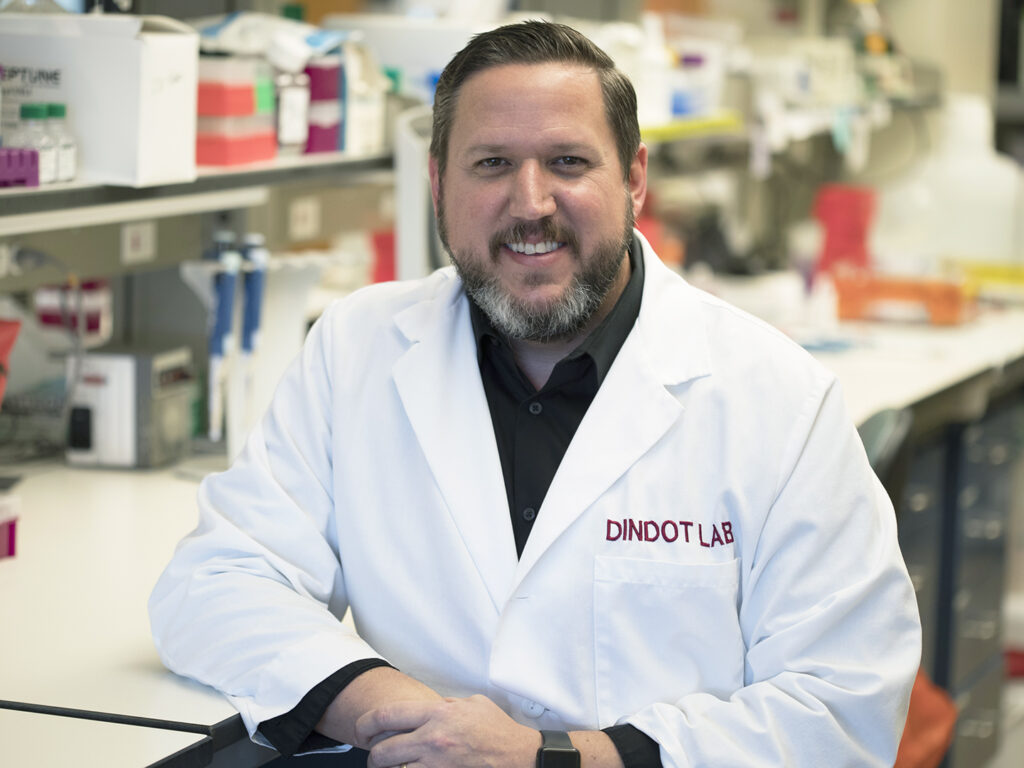Dindot Receives Inaugural Chancellor’s Innovation Award
Story by Rachel Knight, VMBS Communications

Dr. Scott Dindot, an associate professor in the Texas A&M School of Veterinary Medicine & Biomedical Sciences’ Department of Veterinary Pathobiology and in the School of Medicine’s Department of Molecular & Cellular Medicine, was named the inaugural Chancellor’s Innovation Award recipient at The Texas A&M University System Innovation Luncheon on April 14.
The Chancellor’s Innovation Award recognizes one employee from an institution within the Texas A&M University System who has made a remarkable achievement through their discovery and invention.
Dindot works with a specific gene implicated in a rare disorder, Angelman syndrome (AS), and has developed a targeted drug therapy — now known as GTX-102 — that “goes after the heart of the condition,” according to Dindot. His drug therapy was the subject of a $75 million acquisition by Ultragenyx Pharmaceutical, Inc., which is leading the continued development of the treatment.
Previously, Dindot was honored as a 2021 Chancellor’s Enhancing Development and Generating Excellence in Scholarship (EDGES) fellow and was recognized as a 2019 Innovation Awards recipient.
AS affects approximately one in 15,000 live births per year; the disorder is caused by a loss of function of the UBE3A gene, which leads to developmental delay, absent speech, movement or balance disorder, and seizures.
Currently, there is no cure for AS, and available treatments tend to focus solely on behavioral therapies and controlling the symptoms. However, researchers have reported improvements in measurements of disease severity and quality of life for AS patients in the phase ½ study of GTX-102, leading Ultragenyx to believe the novel, targeted therapeutic could be a promising treatment for the disorder.
“This groundbreaking work not only highlights the strong science being conducted in the School of Veterinary Medicine & Biomedical Sciences but also demonstrates how researchers in our school are finding novel solutions to real-world problems that can improve the lives of both animals and human beings,” said Dr. John R. August, the Carl B. King Dean of Veterinary Medicine at Texas A&M.
Dindot’s drug is the first molecular therapeutic for AS to advance into clinical development.
“This is a really great example of the successful commercialization of a technology from the research stage to the clinical development of a promising therapeutic with a company,” said Janie Hurley, acting lead for licensing at Texas A&M Innovation, who oversees the development of commercialization and intellectual property protection strategies for technologies created by A&M researchers. “We strive to ensure that new discoveries such as this one have the best chance possible to reach those in society who could benefit. Working with companies like Ultragenyx is how we accomplish this goal.”
###
For more information about the Texas A&M School of Veterinary Medicine & Biomedical Sciences, please visit our website at vetmed.tamu.edu or join us on Facebook, Instagram, and Twitter.
Contact Information: Jennifer Gauntt, Director of VMBS Communications, Texas A&M School of Veterinary Medicine & Biomedical Sciences, jgauntt@cvm.tamu.edu, 979-862-4216


